
The Basics:
- For ages 5 and up
- For 2 to 4 players
- Approximately 15 minutes to complete
Geek Skills:
- Active Listening & Communication
- Counting & Math
- Logical & Critical Decision Making
- Reading
- Risk vs. Reward
- Semi-Cooperative & Team Play
- Hand/Resource Management
Learning Curve:
- Child – Easy
- Adult – Easy
Theme & Narrative:
- Raid the dungeon as a team, but only one player will emerge victorious…maybe.
Endorsements:
- Gamer Geek rejected!
- Parent Geek mixed!
- Child Geek approved!
Overview
Turtle Rock has been on the maps for as far back as any Sage cares to remember. It’s a place of dark caves, twisting tunnels, and things best not spoken off. Centuries ago, an ambitious lord used it as a dungeon to hide his treasure. From then on, Turtle Rock has been a destination for young adventurers looking to make a name for themselves and a bit of coin. You now stand before the entrance of Turtle Rock. Are you brave enough to enter? Better yet, are you strong enough to survive?
Little Dungeon: Turtle Rock, designed by Ed DeCoste and published by Supersonic Bionic, is comprised of 14 Monster cards, 22 Weapon cards, 22 Loot cards, and 9 Item cards. The cards are as durable and as thick as your standard playing card. The illustrations by Pablo Cialoni and Michael Fong are well done and do a good job of strengthening the game’s theme.
At the Dungeon’s Entrance
To set up the game, first find and set aside the “Shadow Mage” Monster card.
Second, shuffle the rest of the deck and deal 7 cards to each player. Place the deck of cards face-down in the middle of the playing area. This is the draw deck for the duration of the game. Leave room for a discard pile.
Third, each player examines their hand and completes the following:
- Place all Loot cards face-up in front of the player in a pile. This area is referred to as the player’s “Backpack”.
- Place all “Treasure Chest” Item cards to the middle of the playing area, face-up. This area is referred to as the “Dungeon”.
- Keep all Weapon cards, “Thief” Item cards, “Key” Item cards, and Monster cards. These cards are thematically “at the ready” and can be played to the Dungeon.
That’s it for game set up. Determine who will go first and begin your dungeon adventure! But before you jump into the dark, agree as a group how the winner will be determined (see “The Boss Monster Appears and Ending the Adventure” for more details).
A Beginner’s Guide to Dungeon Delving
There is more to dungeon delving than simply packing some gear, hefting a sword, and entering a hole in the ground. Players need to know how their gear works or they won’t know how to use it. The cards in the game represent equipment, treasure, and monsters. Let’s discuss each in turn.
Weapon Cards
Players have 3 different types of equipment that can be used to defend themselves. These are the “Sword”, “Axe” and “Shield” Weapon cards. The “Sword” and “Axe” Weapon cards inflict damage (indicated by the dagger icons on the card’s top-left corner) and are essential to slaying the nasty things that live in Turtle Rock. The “Shield” Weapon card doesn’t inflict any damage, but can block attacks.
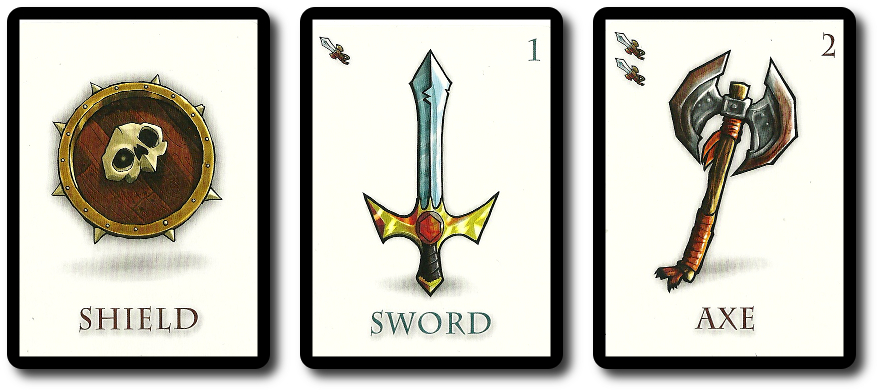
Item Cards
Scattered throughout the dungeon are large treasure chests full of goodness knows what. The “Treasure Chest” Item card can contain any other card in the game. This includes monsters and even another treasure chest. But before a player can open the treasure chest, they must have a “Key” Item card. Using it activates the “Treasure” Item card, releasing the spoils within. However, players cannot hope to open a treasure chest if there are monster’s in the Dungeon.
When a player does open a “Treasure Chest” Item card, the “Key” Item card used is discarded and 3 cards are drawn from the draw pile, but remain face-down. From these 3 cards, the player will select one. The other two go back on the top of the draw pile.
The selected card is handled in the same way as the card drawn at the start of the player’s turn. If it’s a monster or a treasure chest, it goes to the Dungeon area, if it’s loot, it goes to the player’s Backpack, and any other card remains in the player’s hand.
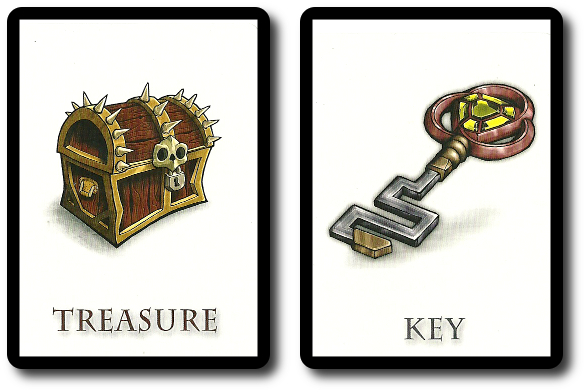
The “Thief” Item card allows the player to be sneaky and steal 1 Loot card from a Monster card, 1 Loot card from an opponent’s Backpack, or 1 randomly selected card from an opponent’s hand. Ironically, stealing from a Monster is significantly less dangerous than stealing from an opponent. Monster’s don’t seem to mind and won’t hold a grudge. The same cannot be said about other players.
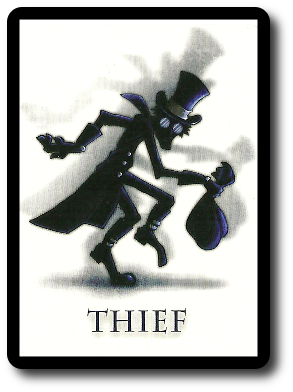
Loot Cards
The only reason anyone would willingly enter a dangerous dungeon like Turtle Rock is the promise of riches. Turtle Rock does contain treasure, but the players will have to search in the dark to find them. Treasure cards represent precious stones and gold coins. An individual Treasure card’s worth is listed on the card’s face in both numbers and symbols.
Loot cards are used to determine the winner of the game, if any players survive the Turtle Rock’s challenges. Loot cards can also be used to bribe monsters.
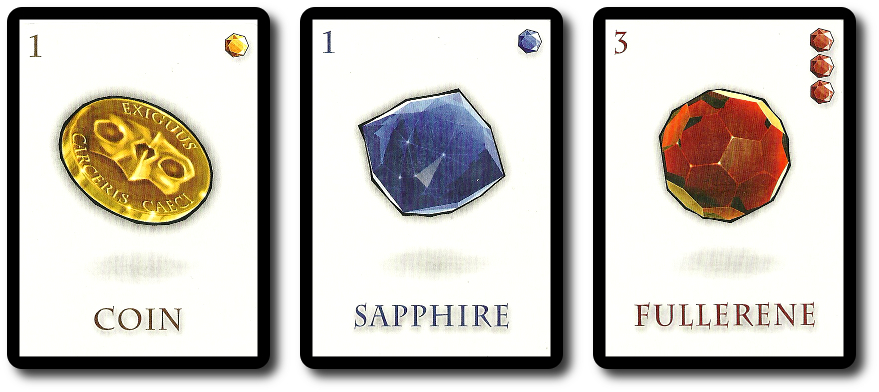
As a point of interest, the coin is engraved with the words “Exiguus Carceris Caeci”, which is Latin for “Little Dungeon”.
Monsters
Turtle Rock is home to some nasty creatures. Each Monster card lists the name of the creature and its health (shown as a number and Heart symbols). Monsters are deadly but they can be reasoned with. If a player cannot engaged the monster in combat with a weapon or a shield, they can bribe the monster by giving them some loot. This will pacify the monster for the moment, but not for long. The monster has a job to do and that is to kill any adventurer who is foolish enough to enter Turtle Rock. However, they are not above making a little money on the side. Being a dungeon monster doesn’t pay as well as you’d think.
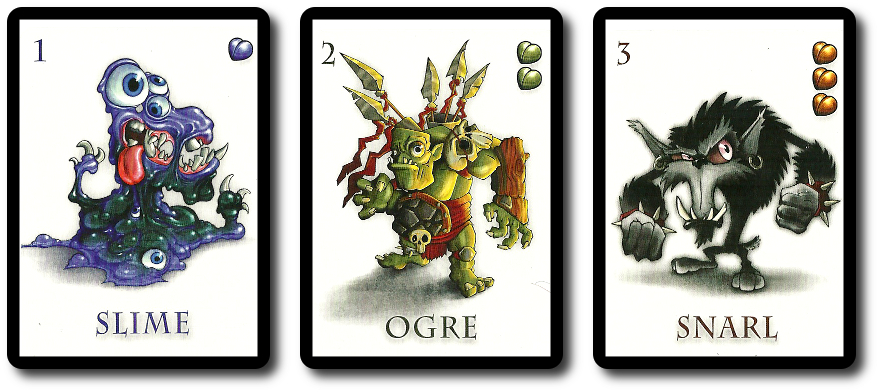
Turtle Rock is not so much owned as it is controlled by the Shadow Mage. This is the dungeon’s “Boss Monster” and he’s not about to let a bunch of riffraff barge into his dungeon without a proper invitation. If the player’s can defeat the Shadow Mage, the rest of the monsters will take the hint and run like crazy, leaving Turtle Rock to the players.

Exploring Turtle Rock
Little Dungeon: Turtle Rock is played in turns with no set number of turns per game. A player’s turn is summarized here.
Step 1: Draw One Card
The first thing a player does on their turn is take the top-most card from the draw deck. The next action taken during this step is dependent on the card drawn.
- If a Loot card is drawn, the player places it in their Backpack area.
- If a Monster card or “Treasure Chest” Item card is drawn, the player place it in the Dungeon area.
- If any other card is drawn, the player keeps it in their hand.
If the draw pile ever runs out of cards, shuffle the discard pile and place it face-down to create a new draw pile.
Step 2: Encounter
If there are any Monster cards in the Dungeon area, the player must encounter them. Each Monster only needs be encountered once and the order in which they are encountered is up to the player. There are 4 ways to resolve each monster encounter.
ATTACK!
Each Monster card has 1 to 4 Heart symbols. These indicate the amount of life the monster has. In contrast, each Weapon card will have 1 to 2 Dagger symbols which indicated damage. The “Sword” Weapon card will do 1 damage and the “Axe” Weapon card will do 2 damage. If a player can attack a monster, they have successfully encountered it, regardless if the monster perishes or not. When played, Weapon cards remain next to the attacked Monster card to help keep track of total damage inflicted.
A Monster card perishes when it takes damage equal to or greater than its indicated health. When the monster perishes, any Loot cards it held are given to the player who slayed it. Then the Monster and any Weapon cards next to it are discarded.
A player can also play one of the Monster cards they have in their hand as an attack. These Monster cards were given to the player during game set up. However, the total life of the Monster card played for the attack must have a life value equal to or greater than the Monster card it’s attacking.
- If both Monster cards have an equal number of health, both monsters perish and are sent to the discard pile along with any Weapon cards. The player gets the Loot cards.
- If the played Monster card has more health, the attached Monster card perishes and is discarded along with any Weapon cards. The player gets the Loot cards, but the played Monster card remains in the Dungeon area and must be encountered by the next player!
Defend!
If a player has the “Shield” Weapon card, they can encounter the monster by blocking its attack. Shields do not damage to the monster. Like the other Weapon cards, “Shield” Weapon cards remain next to the Monster card when played.
Bribe?
If a player doesn’t have a Monster or Weapon card to defend or attack with, or they choose not to use such cards, they must bribe the Monster using one of their Loot cards. The player takes 1 Loot card of their choice from their Backpack area and slides it underneath the Monster. The Monster is now holding Loot that can be claimed by the player who slays it.
Depending on how the winner of the game will be determined (see “The Boss Monster Appears and Ending the Adventure” below), a player will either need to think hard about what Loot card to place or they can place any Loot card they have in their Backpack area.
Step 3: The Adventure Ends or Continues…
If the player is unable to play a Weapon, Monster, or Loot card to every Monster card in the Dungeon area, their adventure ends. They are out for the duration of the game.
If the player was able to encounter each Monster, they have survived for another round.
Either way, the player’s turn is now over and the next player in turn order sequence now goes.
The Boss Monster Appears and Ending the Adventure
At any time during the game the last card in a player’s hand is used, the Boss Monster appears with a flash of dark magic. The “Shadow Mage” Monster card set aside during game set up is now placed in the Dungeon area and is treated like a normal monster with one exception. If the Boss Monster perishes, the game immediately ends regardless of how many other Monster cards might be in the Dungeon area. Thematically speaking, when the Boss Monster falls to the players, all the other monsters take off running. While the “Shadow Mage” Monster card is in the Dungeon area, players can open “Treasure Chests” Item cards if they think it’ll help.
If the “Shadow Mage” Monster card perishes, all the players still in the game now count up their points. There are two ways to do this.
For New Adventurers
If playing with Child Geeks, players count the total number of Loot cards they have in their Backpack area. Ignore the number values on the Loot cards. The player with the most Loot cards wins the game.
For Veteran Adventurers
If playing with more experienced players and those who can tackle some easy math, players add the number values of their Loot cards in their Backpack area. The player with the greatest total number wins the game.
House Rules
Because Little Dungeon: Turtle Rock is language independent and the rules are very light, it’s easy to modify the game play. I’ve listed here the more popular House Rules our players invented. Feel free to include them in your own games.
Ninja Shadow Mage Surprise!
Instead of setting the “Shadow Mage” Monster card aside and only bringing it into play when a player no longer has any cards in their hand, mix it with the deck. When the “Shadow Mage” Monster card appears, play it as normal to the Dungeon area. When the Shadow Mage falls, the game ends as normal. Games might be longer than normal or very short. One thing is for certain, you never know when the Shadow Mage will appear!
Monster Damage
Instead of only being able to play Monster cards to other Monster cards with fewer or equal number of points, allow players to play Monster cards like a Weapon card. Keep them stacked next to the Monster they are attacking and add the damage they inflict along with any Weapon cards used. In this way, weaker Monster cards can do damage to stronger Monster cards. Using this rule allows a Slime monster (the weakest in the game) to perform a coup d’état on the Shadow Mage (the strongest monster in the game)! Go, Slime, go!
Less Greedy Monsters
When a Monster card collects a number of Loot cards equal to or greater than their health, they are discarded along with the Loot and Weapon cards they hold. This allows players to reduce the total number of Monster cards in the Dungeon area even if they don’t have weapons, but doing so costs them points. It also makes playing the “Thief” Item card a jerk move. The Shadow Mage is a greedy bastard, so this trick won’t work on him.
To learn more about Little Dungeon: Turtle Rock, visit the game’s website.
Final Word
The Child Geeks easily grasped the game’s fundamentals and jumped headfirst into the dungeon. They quickly learned that cooperation was necessary to play the game, but not to win it. According to one Child Geek, “You have to help each other, but not all the time. Sometimes you want your brother to get eaten by a monster.” Hmm…deep and dark. Hand management is essential, but not every Child Geek understood the value of the cards they played. As one Child Geek put it, “I don’t care if I give the monster a diamond. I can always get it back.” Yes, but only if the player kills the monster. Which might have been the Child Geek’s intent. The only aspect of the game the Child Geeks didn’t like was the inability to do anything to defend themselves from monsters. Or, more importantly, the lack of cooperation from their peers when they were in trouble. But this is what the game is about, making friends in the short-term in hopes of winning the game in the long-run. When the Child Geeks put their hurt feelings aside, they all agreed to approve the game. They also agreed that the Shadow Mage was a jerk.
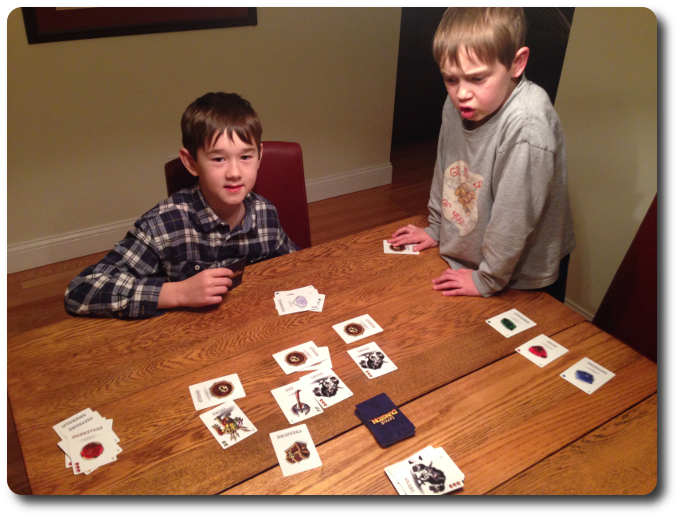
One of my little geeks is not happy. Can you guess which one?
The Parent Geeks enjoyed Little Dungeon: Turtle Rock as a family game, but were not convinced it was a game they would like to play with just their peers. As one Parent Geek put it, “It’s an easy game to teach and to play. It’s also an easy game to get tired of real fast.” The Parent Geeks biggest gripe about the game was that it felt almost entirely reactionary. One Parent Geek said, “I feel like the most incompetent adventurer in the history of the world. Why can’t I take back my sword or simply just runaway or leave the dungeon?” Because that’s not the game. Little Dungeon: Turtle Rock is about going the distance and making it out the other side. Most of the Parent Geeks got that, but some found the game to be an exercise in frustration with very little fun. When the cards were put away the Parent Geeks agreed that Little Dungeon: Turtle Rock was an alright game to play with their family, but not a game they would play with adults.
The Gamer Geeks thought Little Dungeon: Turtle Rock was a mess. According to one Gamer Geek, “This game looks strategic, but it’s just a random luck fest. Having good cards will trump being a strong player every time.” Another Gamer Geek said, “Not only do I feel like this game was designed to make players lose each time, but I am also of the opinion you win by luck alone.” Another Gamer Geek responded, “All you can do is play a card and play a card and play a card. The only goal is to last longer than your friends, but without friends, you cannot hope to survive the dungeon!” It was this strange mix of semi-cooperative game play with no real ability for players to assist each other that left all the Gamer Geeks with a bitter taste in their mouth. As a result, the Gamer Geeks rejected the game.
Little Dungeon: Turtle Rock is really a semi-cooperative game. This is not an adventure you can survive on your own. Players must talk to each other and come up with a battle plan or they will fail. The total points a player has is always visible, so there is no need to be coy with opponents, but there is some bluffing to be had when it comes to what cards the player may or may not have in their hand. Because of this, Little Dungeon: Turtle Rock reminds me of a much easier to play and quicker version of Cutthroat Caverns, another semi-cooperative card game I am very fond of. In both games, players must work together to survive, but there is only ever 1 winner. Unlike Cutthroat Caverns, Little Dungeon: Turtle Rock is much more casual and streamlined. What is lacks in-depth it makes up for in speed and ease of play.
Which is not to say that Little Dungeon: Turtle Rock is a better game. I find it to be very frustrating at times. Scratch that. Most of the time. All of my adventures into the dungeon have started out very positive, but I have never emerged triumph. Not once. I have seen other games where players have won, so I don’t think the game is unbeatable, but I cannot help but question if the game is so random as to cause unbalance. For example, there were a number of games where the Boss Monster emerged and players were bribing like crazy in hopes of buying time to find Weapon cards. They didn’t and each player perished one by one. Another time, all the player’s were simply outnumbered in the Dungeon area or had no cards to defend or bribe with.
This does suggest that players need to do a lot of hand management and keep a close watch on the Dungeon area in order to survive. If all the players were working as a team and victory was shared, I don’t think this would be such a big deal. Players would purposely short themselves cards so as to summon the Boss Monster early allowing their team members to destroy it with their Weapon cards. But this is a semi-cooperative game, which means players only help each other to a point. No one wants to be taken advantage of or be cheated. This lack of true teamwork between the players gives the monsters a huge advantage.
So does the difficulty of the game come from the player’s inability to work as a team or is the game nigh impossible to beat due to the random cards and inability to create a worthwhile strategy? Perhaps a bit of both.
But consider this. The endgame requires at least 1 player to run out of cards in their hand, thus limiting that player for the duration of the game. At the same time, limiting a player’s ability to take action reduces the odds that the other players will survive. Some have said that there is no strategy to be had in Little Dungeon: Turtle Rock, but I think the strategy is pretty clear: don’t limit your choices.
Little Dungeon: Turtle Rock is a surprisingly difficult game to win at times, which resulted in some of our players thinking it was broken or unbalanced. I am undecided and continue to play it. The Child Geeks love playing the game and the Parent Geeks don’t mind it, but the Gamer Geeks just wanted to be done with it, despite admitting that it was an interesting game AFTER playing it many times in a row.
This is a casual game that has teeth. It’s an easy game to learn, but not an easy game to beat. You will feel a bit bullied at times and don’t be surprised if you start to consider giving up card games for good. One thing is for certain, Little Dungeon: Turtle Rock is bigger and badder than it first appears. Don’t let those cute monster illustrations fool you. This game wants to eat you.
This game was given to Father Geek as a review copy. Father Geek was not paid, bribed, wined, dined, or threatened in vain hopes of influencing this review. Such is the statuesque and legendary integrity of Father Geek.




So I got this game for a friend. And the cards are cool. The rules are really badly designed. Weve been trying to tweak it to make it more competitive.
Less Punishing Doom Event:
Shadow mage is shuffled into the deck after the first cycling of the discards.
Speedier play:
Draw 2 cards. Take up to 1 non monster. Other card is given to monsters if loot or discarded. (haven’t tried this with bribable monsters yet)
Bribable monsters:
Monsters bribed for more total than Health value dissappear losing all items.
Exp is it’s own reward :
Take a card every time you kill a monster. Not bribe or devour. (only way to get monster cards aside from treasure and starting items)
Loot the room:
You can loot 1 chest after defeating any monster. If you have a key.
Better Chests:
The starting rule of “draw 3 cards face down and pick one” made no sense since you’re already blindly drawing cards. Instead: draw 3 and keep 2 cards discard the other
Still need to fix sheild a bit IMO
Thanks for taking the time to leave a comment, Conor.
Yes, the rules for the game are less than fully flushed out, but there is enough there to get the game going. As you and your group quickly discovered, the game is either entirely too punishing or exceedingly too easy at times, leaving many (including myself) wondering if the game was being played correctly. Like you, my groups came up with their own House Rules to keep the game balanced and entertaining. Yours are excellent. Thank you very much for sharing them!
If nothing else Little Dungeon is a game that can be easily modified.